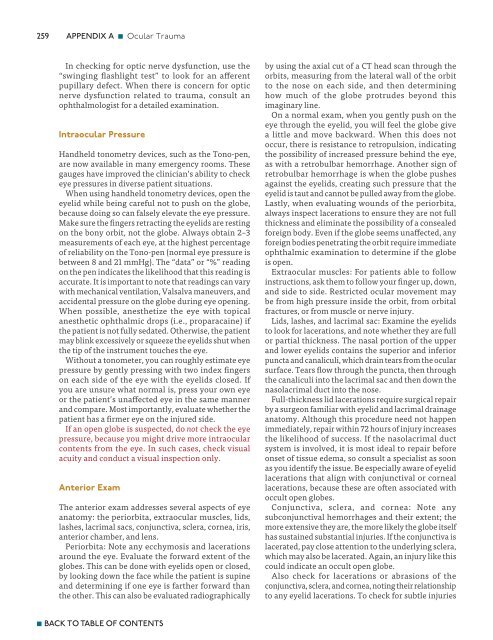Advanced Trauma Life Support ATLS Student Course Manual 2018
Create successful ePaper yourself
Turn your PDF publications into a flip-book with our unique Google optimized e-Paper software.
259<br />
APPENDIX A n Ocular <strong>Trauma</strong><br />
In checking for optic nerve dysfunction, use the<br />
“swinging flashlight test” to look for an afferent<br />
pupillary defect. When there is concern for optic<br />
nerve dysfunction related to trauma, consult an<br />
ophthalmologist for a detailed examination.<br />
Intraocular Pressure<br />
Handheld tonometry devices, such as the Tono-pen,<br />
are now available in many emergency rooms. These<br />
gauges have improved the clinician’s ability to check<br />
eye pressures in diverse patient situations.<br />
When using handheld tonometry devices, open the<br />
eyelid while being careful not to push on the globe,<br />
because doing so can falsely elevate the eye pressure.<br />
Make sure the fingers retracting the eyelids are resting<br />
on the bony orbit, not the globe. Always obtain 2–3<br />
measurements of each eye, at the highest percentage<br />
of reliability on the Tono-pen (normal eye pressure is<br />
between 8 and 21 mmHg). The “data” or “%” reading<br />
on the pen indicates the likelihood that this reading is<br />
accurate. It is important to note that readings can vary<br />
with mechanical ventilation, Valsalva maneuvers, and<br />
accidental pressure on the globe during eye opening.<br />
When possible, anesthetize the eye with topical<br />
anesthetic ophthalmic drops (i.e., proparacaine) if<br />
the patient is not fully sedated. Otherwise, the patient<br />
may blink excessively or squeeze the eyelids shut when<br />
the tip of the instrument touches the eye.<br />
Without a tonometer, you can roughly estimate eye<br />
pressure by gently pressing with two index fingers<br />
on each side of the eye with the eyelids closed. If<br />
you are unsure what normal is, press your own eye<br />
or the patient’s unaffected eye in the same manner<br />
and compare. Most importantly, evaluate whether the<br />
patient has a firmer eye on the injured side.<br />
If an open globe is suspected, do not check the eye<br />
pressure, because you might drive more intraocular<br />
contents from the eye. In such cases, check visual<br />
acuity and conduct a visual inspection only.<br />
Anterior Exam<br />
The anterior exam addresses several aspects of eye<br />
anatomy: the periorbita, extraocular muscles, lids,<br />
lashes, lacrimal sacs, conjunctiva, sclera, cornea, iris,<br />
anterior chamber, and lens.<br />
Periorbita: Note any ecchymosis and lacerations<br />
around the eye. Evaluate the forward extent of the<br />
globes. This can be done with eyelids open or closed,<br />
by looking down the face while the patient is supine<br />
and determining if one eye is farther forward than<br />
the other. This can also be evaluated radiographically<br />
by using the axial cut of a CT head scan through the<br />
orbits, measuring from the lateral wall of the orbit<br />
to the nose on each side, and then determining<br />
how much of the globe protrudes beyond this<br />
imaginary line.<br />
On a normal exam, when you gently push on the<br />
eye through the eyelid, you will feel the globe give<br />
a little and move backward. When this does not<br />
occur, there is resistance to retropulsion, indicating<br />
the possibility of increased pressure behind the eye,<br />
as with a retrobulbar hemorrhage. Another sign of<br />
retrobulbar hemorrhage is when the globe pushes<br />
against the eyelids, creating such pressure that the<br />
eyelid is taut and cannot be pulled away from the globe.<br />
Lastly, when evaluating wounds of the periorbita,<br />
always inspect lacerations to ensure they are not full<br />
thickness and eliminate the possibility of a consealed<br />
foreign body. Even if the globe seems unaffected, any<br />
foreign bodies penetrating the orbit require immediate<br />
ophthalmic examination to determine if the globe<br />
is open.<br />
Extraocular muscles: For patients able to follow<br />
instructions, ask them to follow your finger up, down,<br />
and side to side. Restricted ocular movement may<br />
be from high pressure inside the orbit, from orbital<br />
fractures, or from muscle or nerve injury.<br />
Lids, lashes, and lacrimal sac: Examine the eyelids<br />
to look for lacerations, and note whether they are full<br />
or partial thickness. The nasal portion of the upper<br />
and lower eyelids contains the superior and inferior<br />
puncta and canaliculi, which drain tears from the ocular<br />
surface. Tears flow through the puncta, then through<br />
the canaliculi into the lacrimal sac and then down the<br />
nasolacrimal duct into the nose.<br />
Full-thickness lid lacerations require surgical repair<br />
by a surgeon familiar with eyelid and lacrimal drainage<br />
anatomy. Although this procedure need not happen<br />
immediately, repair within 72 hours of injury increases<br />
the likelihood of success. If the nasolacrimal duct<br />
system is involved, it is most ideal to repair before<br />
onset of tissue edema, so consult a specialist as soon<br />
as you identify the issue. Be especially aware of eyelid<br />
lacerations that align with conjunctival or corneal<br />
lacerations, because these are often associated with<br />
occult open globes.<br />
Conjunctiva, sclera, and cornea: Note any<br />
subconjunctival hemorrhages and their extent; the<br />
more extensive they are, the more likely the globe itself<br />
has sustained substantial injuries. If the conjunctiva is<br />
lacerated, pay close attention to the underlying sclera,<br />
which may also be lacerated. Again, an injury like this<br />
could indicate an occult open globe.<br />
Also check for lacerations or abrasions of the<br />
conjunctiva, sclera, and cornea, noting their relationship<br />
to any eyelid lacerations. To check for subtle injuries<br />
n BACK TO TABLE OF CONTENTS

















